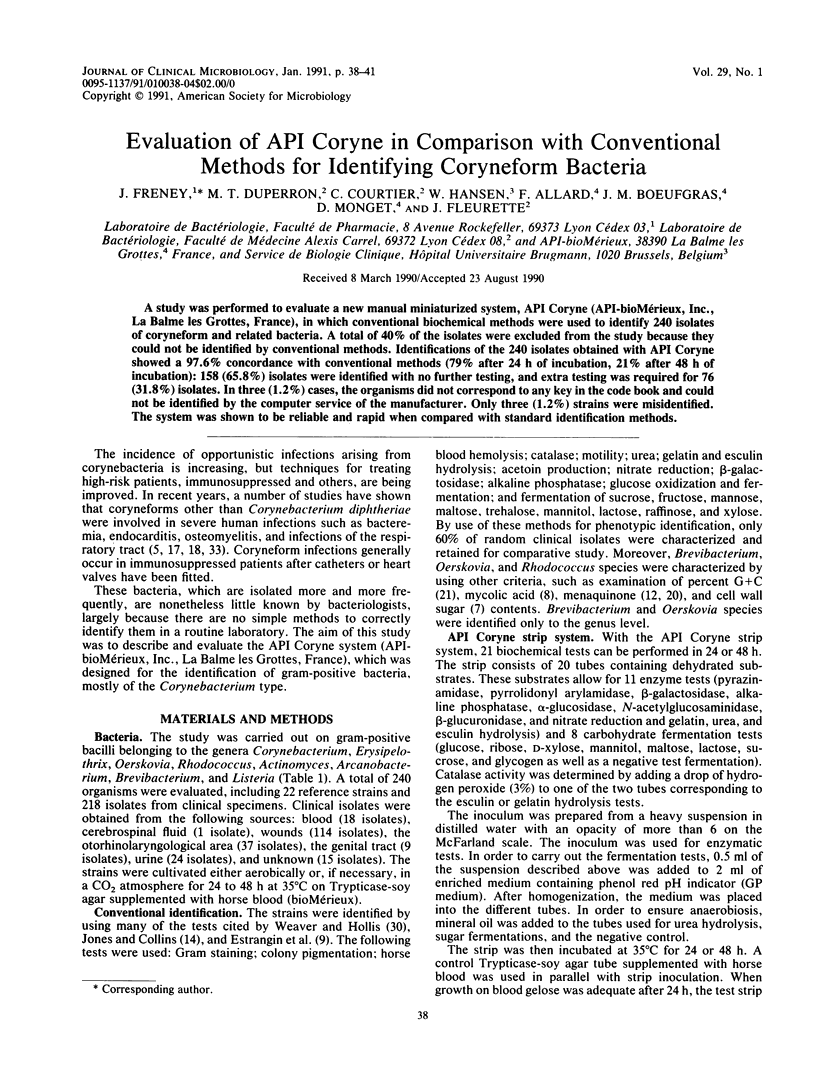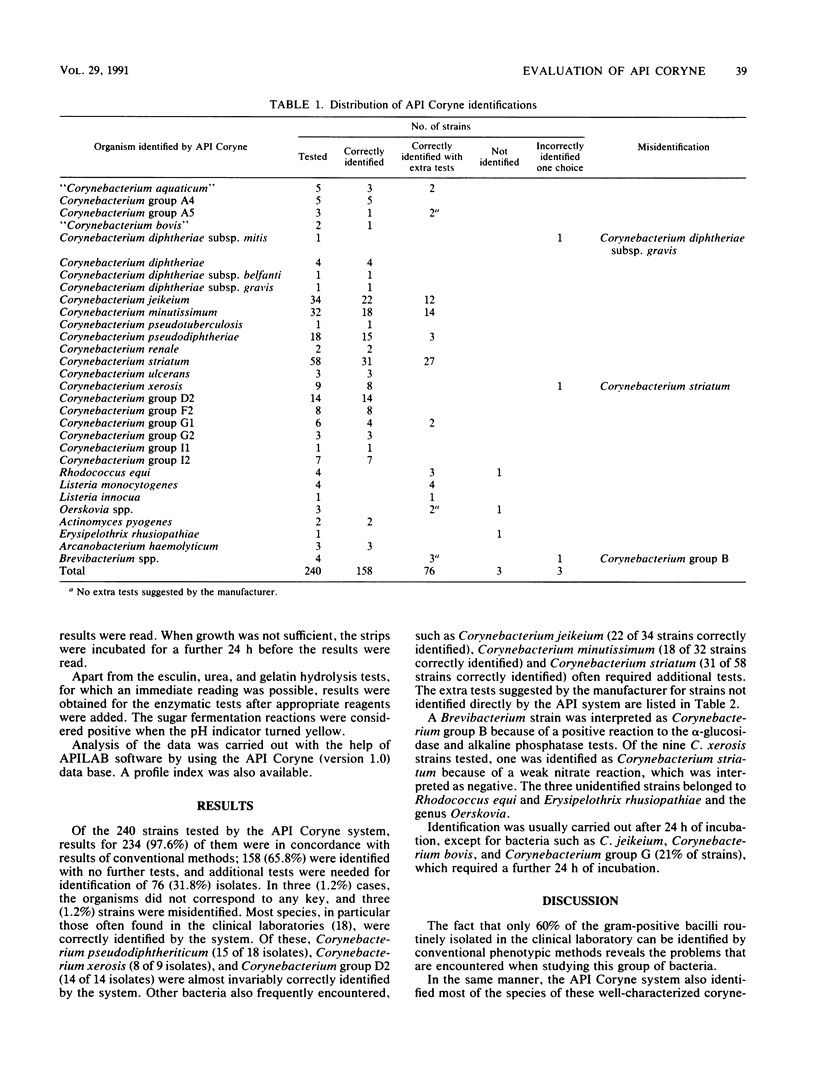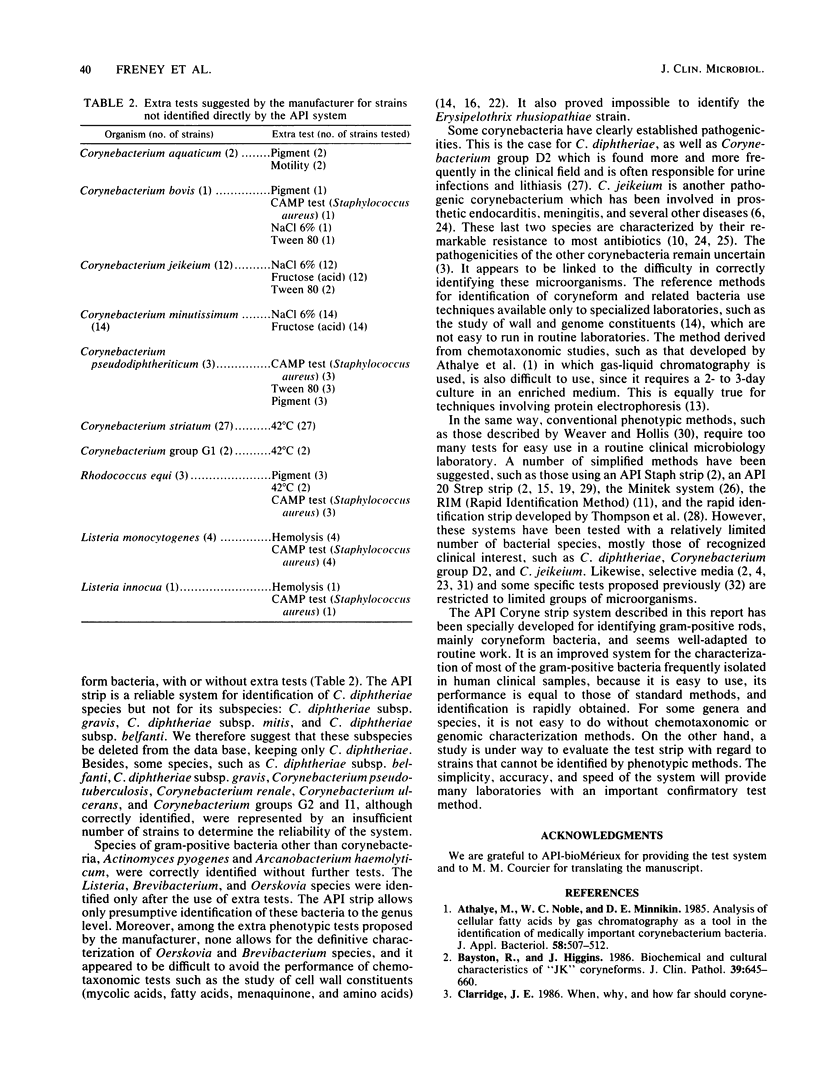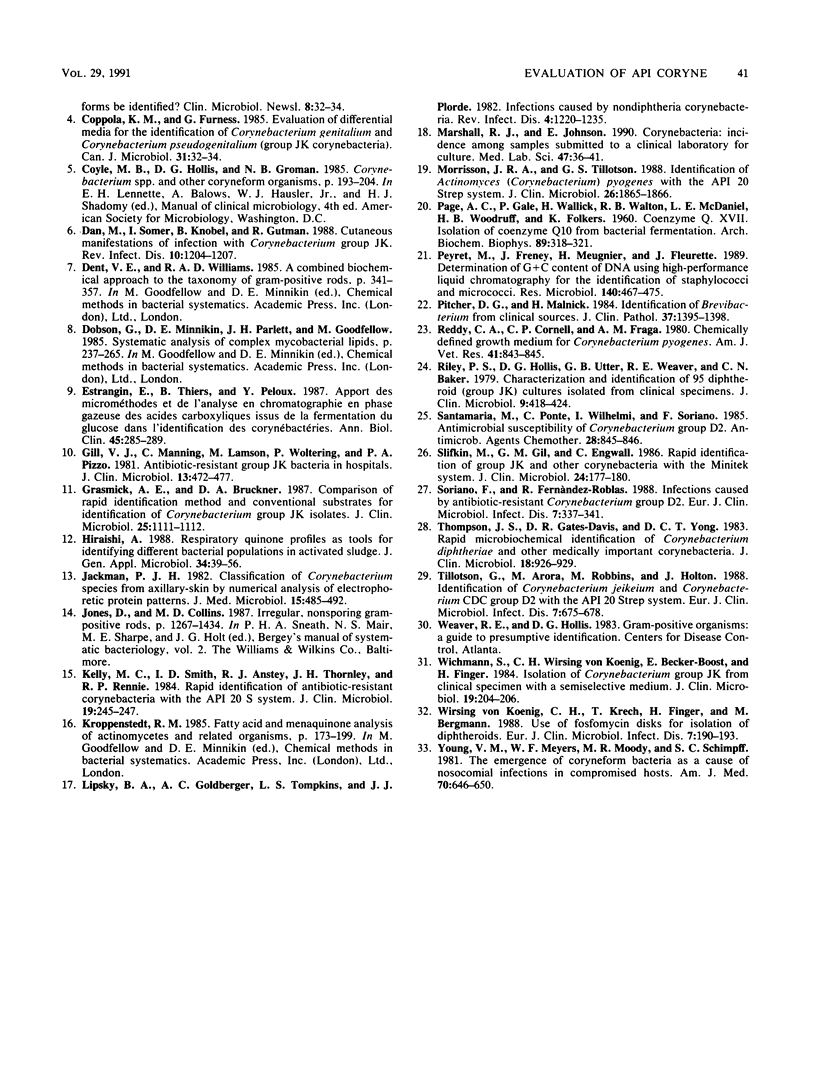Abstract
A study was performed to evaluate a new manual miniaturized system, API Coryne (API-bioMérieux, Inc., La Balme les Grottes, France), in which conventional biochemical methods were used to identify 240 isolates of coryneform and related bacteria. A total of 40% of the isolates were excluded from the study because they could not be identified by conventional methods. Identifications of the 240 isolates obtained with API Coryne showed a 97.6% concordance with conventional methods (79% after 24 h of incubation, 21% after 48 h of incubation): 158 (65.8%) isolates were identified with no further testing, and extra testing was required for 76 (31.8%) isolates. In three (1.2%) cases, the organisms did not correspond to any key in the code book and could not be identified by the computer service of the manufacturer. Only three (1.2%) strains were misidentified. The system was shown to be reliable and rapid when compared with standard identification methods.
Full text
PDF



Selected References
These references are in PubMed. This may not be the complete list of references from this article.
- Athalye M., Noble W. C., Minnikin D. E. Analysis of cellular fatty acids by gas chromatography as a tool in the identification of medically important coryneform bacteria. J Appl Bacteriol. 1985 May;58(5):507–512. doi: 10.1111/j.1365-2672.1985.tb01491.x. [DOI] [PubMed] [Google Scholar]
- Bayston R., Higgins J. Biochemical and cultural characteristics of "JK" coryneforms. J Clin Pathol. 1986 Jun;39(6):654–660. doi: 10.1136/jcp.39.6.654. [DOI] [PMC free article] [PubMed] [Google Scholar]
- Coppola K. M., Furness G. Evaluation of differential media for the identification of Corynebacterium genitalium and Corynebacterium pseudogenitalium (group JK corynebacteria). Can J Microbiol. 1985 Jan;31(1):32–34. doi: 10.1139/m85-008. [DOI] [PubMed] [Google Scholar]
- Dan M., Somer I., Knobel B., Gutman R. Cutaneous manifestations of infection with Corynebacterium group JK. Rev Infect Dis. 1988 Nov-Dec;10(6):1204–1207. doi: 10.1093/clinids/10.6.1204. [DOI] [PubMed] [Google Scholar]
- Estrangin E., Thiers B., Peloux Y. Apport des microméthodes et de l'analyse en chromatographie en phase gazeuse des acides carboxyliques issus de la fermentation du glucose dans l'identification des corynébactéries. Ann Biol Clin (Paris) 1987;45(3):285–289. [PubMed] [Google Scholar]
- Gill V. J., Manning C., Lamson M., Woltering P., Pizzo P. A. Antibiotic-resistant group JK bacteria in hospitals. J Clin Microbiol. 1981 Mar;13(3):472–477. doi: 10.1128/jcm.13.3.472-477.1981. [DOI] [PMC free article] [PubMed] [Google Scholar]
- Grasmick A. E., Bruckner D. A. Comparison of rapid identification method and conventional substrates for identification of Corynebacterium group JK isolates. J Clin Microbiol. 1987 Jun;25(6):1111–1112. doi: 10.1128/jcm.25.6.1111-1112.1987. [DOI] [PMC free article] [PubMed] [Google Scholar]
- Jackman P. J. Classification of Corynebacterium species from axillary skin by numerical analysis of electrophoretic protein patterns. J Med Microbiol. 1982 Nov;15(4):485–492. doi: 10.1099/00222615-15-4-485. [DOI] [PubMed] [Google Scholar]
- Kelly M. C., Smith I. D., Anstey R. J., Thornley J. H., Rennie R. P. Rapid identification of antibiotic-resistant corynebacteria with the API 20S system. J Clin Microbiol. 1984 Feb;19(2):245–247. doi: 10.1128/jcm.19.2.245-247.1984. [DOI] [PMC free article] [PubMed] [Google Scholar]
- Lipsky B. A., Goldberger A. C., Tompkins L. S., Plorde J. J. Infections caused by nondiphtheria corynebacteria. Rev Infect Dis. 1982 Nov-Dec;4(6):1220–1235. doi: 10.1093/clinids/4.6.1220. [DOI] [PubMed] [Google Scholar]
- Marshall R. J., Johnson E. Corynebacteria: incidence among samples submitted to a clinical laboratory for culture. Med Lab Sci. 1990 Jan;47(1):36–41. [PubMed] [Google Scholar]
- Morrison J. R., Tillotson G. S. Identification of Actinomyces (Corynebacterium) pyogenes with the API 20 Strep system. J Clin Microbiol. 1988 Sep;26(9):1865–1866. doi: 10.1128/jcm.26.9.1865-1866.1988. [DOI] [PMC free article] [PubMed] [Google Scholar]
- PAGE A. C., Jr, GALE P., WALLICK H., WALTON R. B., McDANIEL L. E., WOODRUFF H. B., FOLKERS K. Coenzyme Q. 17. Isolation of coenzyme Q10 from bacterial fermentation. Arch Biochem Biophys. 1960 Aug;89:318–321. doi: 10.1016/0003-9861(60)90062-x. [DOI] [PubMed] [Google Scholar]
- Peyret M., Freney J., Meugnier H., Fleurette J. Determination of G + C content of DNA using high-performance liquid chromatography for the identification of staphylococci and micrococci. Res Microbiol. 1989 Sep;140(7):467–475. doi: 10.1016/0923-2508(89)90068-5. [DOI] [PubMed] [Google Scholar]
- Pitcher D. G., Malnick H. Identification of Brevibacterium from clinical sources. J Clin Pathol. 1984 Dec;37(12):1395–1398. doi: 10.1136/jcp.37.12.1395. [DOI] [PMC free article] [PubMed] [Google Scholar]
- Reddy C. A., Cornell C. P., Fraga A. M. Chemically defined growth medium for Corynebacterium pyogenes. Am J Vet Res. 1980 May;41(5):843–845. [PubMed] [Google Scholar]
- Riley P. S., Hollis D. G., Utter G. B., Weaver R. E., Baker C. N. Characterization and identification of 95 diphtheroid (group JK) cultures isolated from clinical specimens. J Clin Microbiol. 1979 Mar;9(3):418–424. doi: 10.1128/jcm.9.3.418-424.1979. [DOI] [PMC free article] [PubMed] [Google Scholar]
- Santamaría M., Ponte C., Wilhelmi I., Soriano F. Antimicrobial susceptibility of Corynebacterium group D2. Antimicrob Agents Chemother. 1985 Dec;28(6):845–846. doi: 10.1128/aac.28.6.845. [DOI] [PMC free article] [PubMed] [Google Scholar]
- Slifkin M., Gil G. M., Engwall C. Rapid identification of group JK and other corynebacteria with the Minitek system. J Clin Microbiol. 1986 Aug;24(2):177–180. doi: 10.1128/jcm.24.2.177-180.1986. [DOI] [PMC free article] [PubMed] [Google Scholar]
- Soriano F., Fernández-Roblas R. Infections caused by antibiotic-resistant Corynebacterium group D2. Eur J Clin Microbiol Infect Dis. 1988 Jun;7(3):337–341. doi: 10.1007/BF01962333. [DOI] [PubMed] [Google Scholar]
- Thompson J. S., Gates-Davis D. R., Yong D. C. Rapid microbiochemical identification of Corynebacterium diphtheriae and other medically important corynebacteria. J Clin Microbiol. 1983 Oct;18(4):926–929. doi: 10.1128/jcm.18.4.926-929.1983. [DOI] [PMC free article] [PubMed] [Google Scholar]
- Tillotson G., Arora M., Robbins M., Holton J. Identification of Corynebacterium jeikeium and Corynebacterium CDC group D2 with the API 20 Strep system. Eur J Clin Microbiol Infect Dis. 1988 Oct;7(5):675–678. doi: 10.1007/BF01964252. [DOI] [PubMed] [Google Scholar]
- Wichmann S., Wirsing von Koenig C. H., Becker-Boost E., Finger H. Isolation of Corynebacterium group JK from clinical specimens with a semiselective medium. J Clin Microbiol. 1984 Feb;19(2):204–206. doi: 10.1128/jcm.19.2.204-206.1984. [DOI] [PMC free article] [PubMed] [Google Scholar]
- Wirsing von Koenig C. H., Krech T., Finger H., Bergmann M. Use of fosfomycin disks for isolation of diphtheroids. Eur J Clin Microbiol Infect Dis. 1988 Apr;7(2):190–193. doi: 10.1007/BF01963079. [DOI] [PubMed] [Google Scholar]
- Young V. M., Meyers W. F., Moody M. R., Schimpff S. C. The emergence of coryneform bacteria as a cause of nosocomial infections in compromised hosts. Am J Med. 1981 Mar;70(3):646–650. doi: 10.1016/0002-9343(81)90589-1. [DOI] [PubMed] [Google Scholar]


